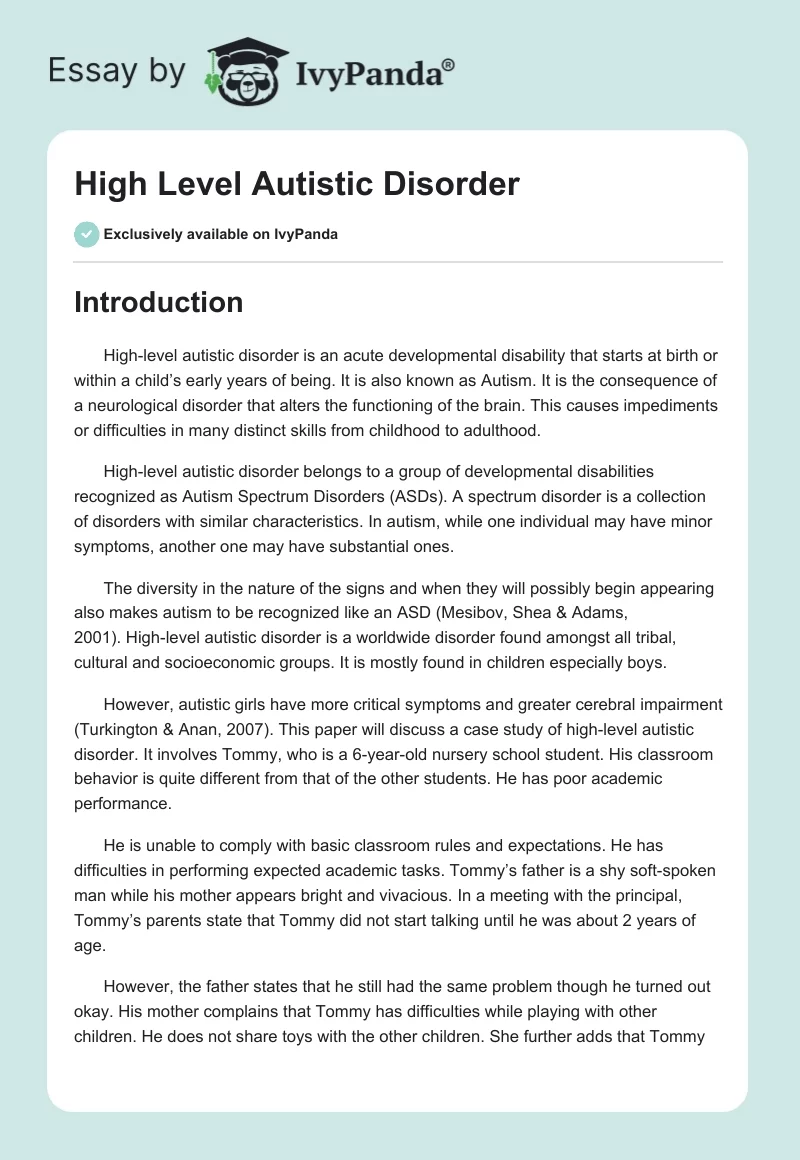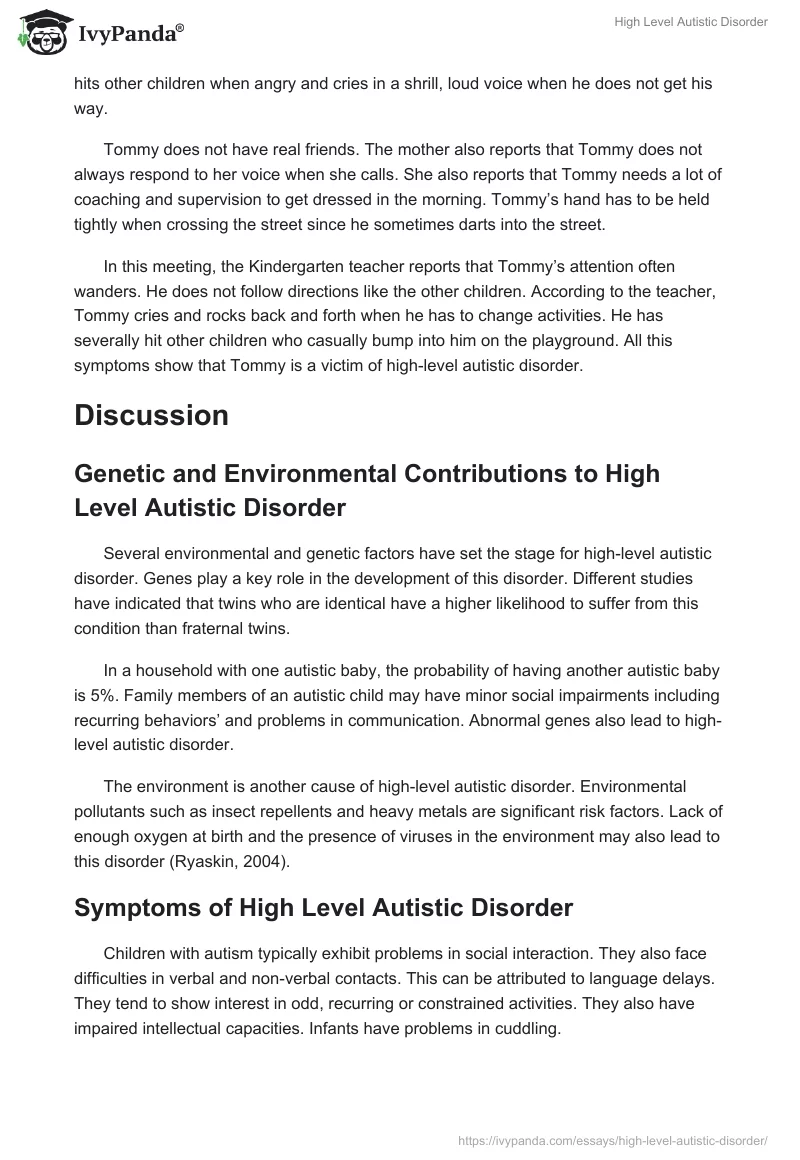Introduction
High-level autistic disorder is an acute developmental disability that starts at birth or within a child’s early years of being. It is also known as Autism. It is the consequence of a neurological disorder that alters the functioning of the brain. This causes impediments or difficulties in many distinct skills from childhood to adulthood.
High-level autistic disorder belongs to a group of developmental disabilities recognized as Autism Spectrum Disorders (ASDs). A spectrum disorder is a collection of disorders with similar characteristics. In autism, while one individual may have minor symptoms, another one may have substantial ones.
The diversity in the nature of the signs and when they will possibly begin appearing also makes autism to be recognized like an ASD (Mesibov, Shea & Adams, 2001). High-level autistic disorder is a worldwide disorder found amongst all tribal, cultural and socioeconomic groups. It is mostly found in children especially boys.
However, autistic girls have more critical symptoms and greater cerebral impairment (Turkington & Anan, 2007). This paper will discuss a case study of high-level autistic disorder. It involves Tommy, who is a 6-year-old nursery school student. His classroom behavior is quite different from that of the other students. He has poor academic performance.
He is unable to comply with basic classroom rules and expectations. He has difficulties in performing expected academic tasks. Tommy’s father is a shy soft-spoken man while his mother appears bright and vivacious. In a meeting with the principal, Tommy’s parents state that Tommy did not start talking until he was about 2 years of age.
However, the father states that he still had the same problem though he turned out okay. His mother complains that Tommy has difficulties while playing with other children. He does not share toys with the other children. She further adds that Tommy hits other children when angry and cries in a shrill, loud voice when he does not get his way.
Tommy does not have real friends. The mother also reports that Tommy does not always respond to her voice when she calls. She also reports that Tommy needs a lot of coaching and supervision to get dressed in the morning. Tommy’s hand has to be held tightly when crossing the street since he sometimes darts into the street.
In this meeting, the Kindergarten teacher reports that Tommy’s attention often wanders. He does not follow directions like the other children. According to the teacher, Tommy cries and rocks back and forth when he has to change activities. He has severally hit other children who casually bump into him on the playground. All this symptoms show that Tommy is a victim of high-level autistic disorder.
Discussion
Genetic and Environmental Contributions to High Level Autistic Disorder
Several environmental and genetic factors have set the stage for high-level autistic disorder. Genes play a key role in the development of this disorder. Different studies have indicated that twins who are identical have a higher likelihood to suffer from this condition than fraternal twins.
In a household with one autistic baby, the probability of having another autistic baby is 5%. Family members of an autistic child may have minor social impairments including recurring behaviors’ and problems in communication. Abnormal genes also lead to high-level autistic disorder.
The environment is another cause of high-level autistic disorder. Environmental pollutants such as insect repellents and heavy metals are significant risk factors. Lack of enough oxygen at birth and the presence of viruses in the environment may also lead to this disorder (Ryaskin, 2004).
Symptoms of High Level Autistic Disorder
Children with autism typically exhibit problems in social interaction. They also face difficulties in verbal and non-verbal contacts. This can be attributed to language delays. They tend to show interest in odd, recurring or constrained activities. They also have impaired intellectual capacities. Infants have problems in cuddling.
They shun from eye contact and do not appear to be in need of affection. They shed tears when picked up. They form no connection with their parents and do not exhibit any concerns towards strangers. They do not train the ordinary games of babyhood. As children with a high-level autistic disorder grow old, they often have extra ordinary reactions to sensory experiences (Blanc & Volkers, 2007).
(DSM) IV Classification of High Level Autistic Disorder
The Diagnostic and Statistical Manual (DSM) IV classify high-level autistic disorder in to three. According to DSM-IV, autism is a qualitative destruction in social interaction and verbal communication. High-level autistic disorder is considered by DSM-IV as constrained, recurring and a stereotyped behavioral pattern (Rapoport & Ismond, 1996).
Brain monitoring techniques
Brain scan involves the use of different techniques to picture the structure and functioning of the brain. Functional Magnetic Resonance Imaging (fMRI) depends on the paramagnetic characteristics of hemoglobin. It enables one to see representations of fluctuating blood supply to the brain connected with neural cavity. This permits images to be created that show which brain parts are activated.
PET (Positron Emission Tomography) detects brain receptors linked to neurotransmitters. It has the capability of detecting chemicals that attach to receptors. Single Photon Emission Computed Photography (SPECT) utilizes gamma rays producing radioisotopes. A gamma camera is used, and a computer comes up with images of the active brain regions.
Injection of a radioactive tracer is then done. This is quickly absorbed by the brain though not redistributed. SPECT reflects blood flow in the cerebrum. MEG (Magneto encephalography) is another non-invasive brain monitoring technique. It determines the magnetic fields generated by electrical actions in the brain (Zager, 2005).
High Level Autistic Disorder Tests and Assessments
Assessment of Verbal and Spatial memory (Differential Ability Scales subtests)
The DAS (Differential Ability Scale) is a cognitive ability test for children aged between 2 and 17 years. It involves diagnostic tests for vocal and non-vocal matters. Verbal subtests involved in DAS are verbal comprehension, vocabulary naming and explanations of similarities between pictures.
Spatial subtests involved in assessment of spatial memory include block building, copying of drawings and recalling of designs. It also involves construction of patterns and the identification of picture similarities (Oller & John, 2009).
Assessment of Verbal Fluency (Differential Ability Scales subtests)
Verbal fluency is the capability to generate a sequence of words under theoretical or phonological demands. The DAS examines verbal fluency through word definitions whereby the victims explain the meaning of words spoken by the assessor. Word reading tests are also done to increase the children’s ability of reading more and more difficult words.
Assessment of Social Cognition (Autism Diagnostic Observation Scale)
This involves a sequence of planned and semi planned activities that entail social interaction between the assessor and the autistic child. The assessor observes and recognizes segments of the child’s behavior. He designates this to predetermined observational classifications. Classified observations are consequently combined to generate quantitative scores for evaluation. ADOS show social and verbal communication behaviors necessary for autism diagnosis (Barker, 2004).
Assessment of Executive Function (NEPSY battery for high functioning Autistic Disorder Children)
This is a neuropsychological assessment test. It evaluates neuropsychological development in autistic children aged between 3 and 16 years. It analyses both straightforward and complex features of cognition that are significant in children’s capability to learn and be industrious at home and in school. It tests cognitive features, which are not, ordinarily covered by the child’s general capacity or achievement batteries (Mesmere, 2008).
Assessment of daily functioning “Vineland”
This refers to the evaluation and monitoring of the daily activities of the child. It is an estimation of a child’s functional status. It involves activities performed usually such as feeding, dressing, bathing and leisure. Vineland Adaptive Behavior Scales is a suitable test to measure a child’s level of daily functioning.
It identifies and categorizes mental retardation with high-level autistic disorder. It is planned within a structure of three domains. These include verbal communication, social interactions and daily living. Vineland can be used to establish educational, recovery and cure programs for autistic children (Schopler & Mesibov, 1988).
Assessment of Intellectual Ability and Achievement
The DAS possibly measures intellectual capacity better than many contending tests because the exceptional diagnostic tests are not involved in the verbal, non-vocal spatial and full scores (Doyle & Iland, 2004).
Assessment of Cognitive Speed
It is an assessment method for approximating and forecasting the amount of functional harm amongst autistic victims. Child’s version of Trails A & B is used together with DAS. The scores are associated with cognitive pointers of functional harm. In Trails A and B, the child links numbers in series followed by letters. He then relates the numbers to the letters in a sequence.
Conclusion
Early intervention in educational settings for a period of not less than two years leads to improved outcomes in most autistic children. It is important for pregnant mothers to avoid taking drugs unless prescribed by the doctor. This is because some instances of this disorder are related to exposure to chemicals in the course of pregnancy.
Encouraging surroundings in the learning establishments, residence and the places of work assist autistic persons to continue developing all through their lives. High-level autistic disorder has no cure. In some cases, the victims may gain speech. Signs of the disorder get mild with age.
Factors such as having an intelligence quotient of more than 50, capacity to communicate before reaching 6 years and having a useful talent imply a better prognosis. Present prognosis for high-level autistic disorder has so much improved. Autistic children are put in institutions. Adult victims have the capacity to work victoriously in mainstream jobs.
Such people, however, need moral support in their efforts for a self-reliant life. Many other victims of autism have the ability to work in exceptional environments under the supervision of managers. Such managers are skilled in dealing with the less fortunate in the society. It is, therefore, clear that the future holds something yummy for victims of high-level autistic disorder (Ozonoff & Portland, 2002).
References
Barker, P. (2004). Basic child psychiatry. Oxford: Blackwell Publishers.
Blanc, L. R., & Volkers, H. (2007). What You Should Know About Autism Spectrum Disorders. Signs, symptoms, treatments and effects on daily life. Bangor: Booklocker.com.
Doyle, T. B. & Iland, D. E. (2004). Autism Spectrum Disorders from A to Z: Assessment, Diagnosis. Texas: Future Horizons Publishers.
Mesibov, B. G., Shea, V., & Adams, W. L. (2001). Understanding Asperger syndrome and high functioning autism. London: Kluwer Academic Publishers.
Mesmere, S.B. (2008). New Autism Research Developments. New York: Nova Science Publishers.
Oller, W. J., & John, S. (2009). Autism: The Diagnosis, Treatment, & Etiology of the Undeniable Epidemic Autism. Sudbury: Toronto Publishers.
Ozonoff, S., & Partland, J.A. (2002). Parent’s guide to Asperger syndrome and high-functioning autism: how to meet the challenges and help your child thrive. New York: Guilford Press
Rapoport, L. J., & Ismond, R. D. (1996). DSM-IV training guide for diagnosis of Childhood disorders.Hoboken: Psychology Press.
Ryaskin, T.O. (2004). Focus on autism research. New York: Nova Science Publishers.
Schopler, E., & Mesibov, B. G. (1988). Diagnosis and assessment in autism. New York: Plenum Press.
Turkington, C., & Anan, R. (2007). The encyclopedia of autism spectrum disorders. New York: Facts on File Publishers.
Zager, B. D. (2005). Autism spectrum disorders: identification, education, and treatment. Routledge: Routledge Publishers.


